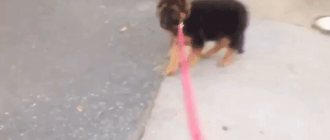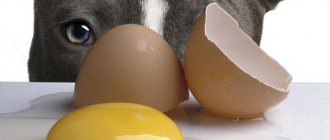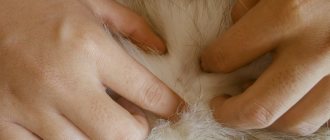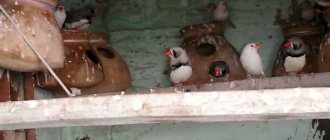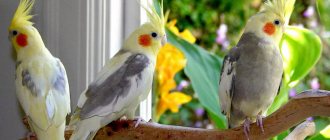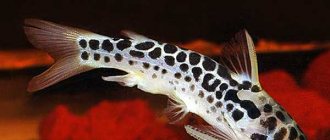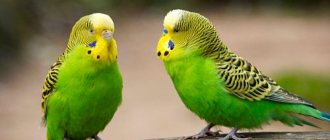Finches are birds from the finch family, which are often kept in captivity. They are small in size, brightly colored and have a pleasant voice. These birds cannot stand being alone, so they are usually kept in pairs or groups. In such conditions, owners often think about starting to breed their pets. Breeding finches at home is a fairly simple task, which nevertheless requires certain measures to be carried out within a specified time frame.
Matching
Successful breeding of finches is impossible without the correct selection of the parent pair. The male and female should be approximately the same age. Amadins become capable of reproduction at 6 months, but to obtain healthy offspring it is better for the birds to be one year old. It is better not to use finches older than 4-5 years for breeding. Old birds often lay unfertilized clutches and take poor care of their chicks. The offspring from such couples are weak and sickly, stunted in growth and often die.
It’s good if the finches chosen as partners live in the same cage and get along peacefully without quarrels or fights. Naturally formed pairs become better parents than those birds that were not previously familiar with each other.
Future parents must be healthy, active, have a neat appearance and bright plumage. The following signs indicate unhealthy birds:
- ruffled feather cover;
- receding hairline;
- discharge from the eyes, nostrils and beak;
- growths on the paws;
- dirty feathers around the cloaca;
- modified droppings (too liquid, mixed with mucus, blood or undigested food particles);
- lethargy;
- lack of appetite.
Such birds must be isolated and treated. They can be bred only after complete recovery.
In addition, finches chosen as breeders should not have external defects that can be inherited by offspring. It is important that the male and female are not related; It is better to purchase them from different breeders. The offspring obtained as a result of inbreeding are often weak and nonviable.
For successful breeding, the selected pair of birds should not be molting. It is advisable that their molt is completed recently, and there is enough time before the next one. The process of changing plumage takes a lot of energy from the bird, and at the same time, the ongoing mating season can deplete the finch’s body and lead to illness.
Finches are prone to obesity. Obese birds often refuse to reproduce, and if chicks appear, the offspring may turn out to be weak and sick. Therefore, before the start of the breeding season, the selected pair must be provided with sufficient exercise by placing them in a spacious enclosure.
How long do finch eggs hatch?
With the correct selection of a pair of finches, observing the nesting structure, you will notice that the male begins mating games. He attracts the female’s attention in every possible way: he ruffles the feathers on the back of his head, flying up to her; begins to sing, slowly approaching the chosen one with short jumps and twitching his tail. Handsome, just a sight for sore eyes!
If the female is ready to reciprocate, then this is expressed in a silent squat with ruffled plumage on her head, cheeks and abdomen. If finches, having sat down next to each other, begin to finger the feathers on each other’s heads, then their union can be considered successful. After a short time, they begin to mate and build a nest in the house.
To do this, they use dry grass, which is first placed in the cage and nesting boxes to attract birds. When the nest is built and the finches have laid eggs (of which there are no more than five in a clutch), the incubation process begins.
This lasts for twelve days, however, not all chicks hatch. This can be caused by infections, as well as parasites that have entered the nest, such as ticks and fleas. The couple incubates the eggs one by one, however, the female, as a rule, spends much more effort on this.
At the initial stage, she often leaves her shelter, walking around and eating, however, as the moment of appearance of the offspring approaches, her departures can be observed less and less often. She leaves the nests only to take food and water; At this time, the support of the male is more important to her than ever: he must replace the female - otherwise she is in danger of exhaustion. But sometimes males shy away from paternal responsibilities, so it is quite problematic to determine how many finch eggs hatch individually.
In such a situation, it is necessary to take great care of the female, adding food of animal origin to her diet to completely saturate the expectant mother.
When the chicks are born, the first step is to pay attention to the balance of the parents' diet: it is necessary to focus on animal food - such as larvae, boiled egg yolks, mealworms and bloodworms. You should be accustomed to such foods even before mating, otherwise the birds may refuse to eat them, which will negatively affect their health, since they will not receive the full range of necessary microelements and nutrients. Remember that breeding these birds is a responsible procedure that requires care.
The right time for breeding
Amadins in captivity are able to bear offspring at any time of the year. The incentive for finches to start breeding is an increase in daylight hours and an increase in temperature, so it is more convenient to plan the appearance of chicks for the summer period. In winter, in order to produce offspring, you will need to additionally illuminate the room with the breeders and ensure that there are no drafts.
Diet
The basis of the amadine's diet is grain mixtures of 6-8 components. It is convenient to use food for exotic birds sold in pet stores. The diet must include protein-rich foods - boiled eggs, low-fat cottage cheese. During the period of preparation for breeding, producers are fed sprouted grain - it is rich in vitamin E, which has a beneficial effect on the reproductive system of birds. It is useful for both females and males to give calcium-rich supplements - chalk, eggshells or shell rock. Females are also given sulfur-containing supplements and vitamins.
Breeding finches
For example, in a rectangular cage they are installed close to the side bars, but so that the finches do not touch the bars with their tails. In addition, the perches should be fixed as far as possible from each other so that the finches can flit from one to another and train their muscles, at least in a short flight. There may be more perches in the aviary, but they should not interfere with the flight of the birds. To prevent finches' claws from growing back, some hobbyists coat the bottom of the perches with clay or glue sandpaper to them. Place paper on the bottom of the cage.
Cage placement.
It is better to place cages with finches along the wall near the window so that the rays of the sun fall on the cages for two to three hours a day. Light and sunlight are of great importance for the general condition of birds, especially during the molting period. In the warm season, the cage with finches should be exposed to sunlight for some time, but not more than 40 minutes. It is better to place cages and indoor enclosures at a distance of 40-50 cm from the floor or higher. They can be installed on a special table-stand.
The duration of daylight hours for birds should be at least 10 and no more than 17 hours. In winter, with short daylight hours, it is necessary to additionally illuminate the cage with the birds, otherwise they will starve. Excessive lighting can cause depression of the nervous system, decreased metabolism, and loss of appetite. When changing food and water daily, you should not make sudden movements; you should approach cages and enclosures carefully, talking to the birds in a low voice. With this kind of treatment, they will quickly get used to the person. The optimal air temperature is 18 - 26°C, humidity from 60 to 70%. Finches require the absence of drafts and sudden temperature changes.
Disinfect the cages more often (at least once a month), then you will avoid the appearance of parasites (bird mites, etc.) in them. Cleanliness in a cage or aviary is one of the main conditions for keeping finches in good condition.
Feeding finches
The main diet of finches consists of a grain mixture (6-8 components). You should buy a mixture for exotic birds in the store - mixtures for canaries and budgerigars are not suitable for feeding finches. The main element is yellow millet (its shell is softer than orange millet). The ratio is approximately this: for 1 kg of millet - 300 g of canary seed, 150 g of oatmeal, 50 g of flaxseed, 100 g of rapeseed, lettuce, mogar, chumise, hemp seeds and 250 g of meadow grass seeds (dandelion, clover, timothy plantain, etc. .). The grain mixture is given once a day in a slight excess (minimum 1 teaspoon per bird per day). You can add various porridges (rice, millet, buckwheat). Fresh greens must be present in the food - various vegetables, fruits, berries. In addition, hard-boiled and chopped eggs are needed in small quantities. In winter, it is useful to add sprouted seedlings of cereals (millet, barley, wheat, oats); in summer, finely chopped lettuce, dandelion, nettle, woodlice, plantain and other plants are added to soft food.
Soft and green food should be completely fresh, and the cages should always contain mineral supplements (chalk, shell rock, river and sea sand, crushed eggshells). Water should be poured at room temperature. DO NOT give:
raw millet (cereals), black bread, parsley, dill, onions, avocado, persimmon. Millet cannot be given for the following reason - it lacks a shell, so the fats on its surface oxidize, toxic substances and pathogenic organisms appear. All this can undermine the health of the bird (information taken from the website: www.rgo.ru).
Shedding
To help your pets survive molting more easily, you should give them sprouted grains, chopped boiled eggs, fruits, vegetables and herbs during this period. It is useful to add crushed eggshells, feed sulfur and Tsamax to the mineral feed for exotic and songbirds.
Reproduction
Finches are flocking birds, so you should not have just one bird - it will get bored. Finches feel most comfortable in a flock, but you can also have a couple of birds - same-sex or opposite-sex. Finches mature early and reproduce easily in captivity. Therefore, you should be prepared for the fact that even at the age of several months they can make their owners happy with unexpected offspring. To prevent this, young finches should be kept separately by sex as soon as their gender is determined.
Zebra finches should be allowed to breed when they are at least 6 months old and should be allowed no more than 3 nestings per year. After this, take a rest break for at least 6 months. to avoid exhaustion of the female’s body. Japanese finches can be bred from the age of at least 9 months. To hatch chicks, weaver birds prefer closed nesting houses, which must first be filled with hay, dry grass, coconut fiber and sphagnum moss. A little of the same building material should be placed in the cage to stimulate the males to build a nest.
During breeding, it is recommended to place the cage with zebra finches on a closet or other place at least 2 m from the floor in the brightest part of the room, where there is no draft. These finches are very shy, so when feeding or incubating chicks, they will become agitated and fly out of the nest box, scattering eggs or chicks. Japanese finches are very quiet and calm birds. The cage with them can be placed at any level from the floor, and they will perfectly incubate eggs and feed chicks even when you approach them.
During one clutch, the female lays 4-7 eggs, one every day. As soon as the female begins to lay eggs, all building material (hay, coconut fiber) must be removed from the cage. Otherwise, the birds may lay eggs on them. Birds begin incubating the clutch from the 4th egg. Incubation duration is 11-17 days. The pair take turns incubating the eggs, replacing each other for rest and food. The chicks are fed by their parents with semi-digested food. After about 17-21 days, the chicks fly out of the nest. After the chicks leave the nest, the parents continue to feed them for some time. Feeding the chicks lasts about a month.
Feeding finches at different periods of life
| Do not give after the 1st egg | Do not give after the 2nd egg | ||
| Don't give. Start feeding 1-2 days before the chicks hatch | Don't give. Start feeding 1-2 days before the chicks hatch | ||
| Chicks are over 7 days old | Start adding carrots, then greens, fruits and bring to daily | ||
| Gradually reduce to 3 times a week | Gradually reduce to once a week | Gradually reduce to once a week | Gradually reduce to once a week |
Socket options
The appearance of a nest is a signal for the beginning of the mating season. For a pair of finches, at least 2 nests are installed in the enclosure. Manufacturers themselves choose the appropriate one. You can offer birds the following nest options:
- Open basket. Constructed from willow twigs, vines or hemp rope. Has an open top.
- Closed basket. It is woven from willow twigs. It looks like a ball with a small entrance.
- Open box. Made from plywood. Does not have a front wall. Equipped with a removable lid and has a recess at the bottom.
Nesting
In the process of breeding finches at home, the owner can observe all stages of nesting. If they proceed correctly, you can count on successful offspring.
Mating games
Before mating, birds organize mating games. During them, the male dances in front of the female, straightens his feathers, treats his partner with pieces of fruit, and may chase her around the enclosure. The female, in response to courtship, dances and whistles.
Nest construction
After the end of the courtship period, the couple begins to build a nest. This process usually takes about a week. At this time, the cage with finches cannot be moved to a new place, otherwise the birds may refuse to breed.
It is necessary to place in advance a sufficient amount of material in the aviary from which the birds can build a nest. Suitable for this purpose:
- twigs;
- moss;
- feathers;
- hay;
- coir;
- pieces of paper.
The materials are laid out along the bottom of the enclosure, pushed between the bars of the cage and placed in the nesting chamber. Birds should not be provided with threads, cotton wool or scraps of fabric. Finches can become entangled in them and damage their legs.
On a note! Once the nest is built, unused materials should be removed. If left in the enclosure, finches may begin to build a new nest, abandoning the first clutch.
Laying and incubating eggs
The female begins laying eggs a week after mating. She lays 1 egg per day. In total, a clutch can contain from 3 to 7 eggs. Incubation of the clutch begins when 2-3 eggs are laid. Both parents incubate the eggs of finches. They take turns leaving the nest, going for food and water. If the female constantly sits on the eggs and does not leave the clutch, the male brings her food to the nest.
During this period, birds should not be disturbed. It is not recommended to make noise, come close to the enclosure or look into the nest. If for any reason you need to move the eggs (for example, to give them to foster parents), you should use a spoon. You should not touch the eggs with your hands, otherwise the birds will refuse to incubate them.
The incubation period for eggs lasts about 14-17 days. During this time, the room with finches must maintain a temperature of at least 20°C and avoid drafts. Air humidity should be at 60-70%.
The appearance of chicks
Amadine chicks hatch on the 15-17th day of incubation. They are blind and covered with gray down. They have luminous markings at the corners of their beaks, which help parents locate chicks in a dark nest.
Care of offspring
Parents feed the chicks with semi-digested food from the crop. During the period of feeding the offspring, it is necessary to increase the supply of soft food to the birds - cottage cheese, boiled eggs, insects.
If the parents refuse to feed the chicks, they will have to be artificially fed. In this case, the chicks are taken from the nest and placed in a box lined with hay or cloth. The top is covered with fabric. The box is placed near a heating source so that the temperature inside it reaches 38°C in the first week of the chicks’ life, 35°C in the second and 25°C in the third. A container of water is placed next to the box to maintain air humidity at 60-70%.
Feeding of the chicks begins after the separation of the original feces. In the first 3 days, food is given every half hour during the day and every 2 hours at night. In the next 4 days, the break between daytime feedings is increased to 1.5 hours, and between night feedings - up to 3 hours. Over the next 8 days, the chicks are fed every 2 hours during the day, and at night they take a break from 0:00 to 6:00. In the next 15 days, the intervals between daily feedings are increased to 4 hours.
For feeding, use infant formula without milk or special food for chicks. The food should have a liquid consistency and a temperature of 39°C. It is given to chicks using a disposable syringe without a needle.
Attention! Cleaning of the aviary with chicks is carried out 2 weeks after their hatching. If you start cleaning the enclosure before this time, the parents may abandon the chicks.
At the age of 20 days, the chicks begin to fly out of the nest. They begin to feed on their own at the age of 1 month. To accustom the chicks to adult food, they are first given boiled sweetened millet. After 7 days they are offered wet mash, and after another week - sprouted grain and grass seeds.
After the chicks have completely switched to feeding on their own, they must be removed from their parents. Adult finches begin to prepare for a new clutch and may peck at their first brood.
What to feed finches chicks at home
With careful selection of parents and a high level of their consciousness, there is no need to worry about the nutrition of babies during the first 3 weeks. But if everything happened exactly the opposite, then responsibility for the diet falls on the shoulders of the breeder.
Natural feeding
The first time after birth, the female is responsible for feeding the offspring, while the male feeds only her at this time. Babies signal their hunger not only by squeaking, but also by wide-opening their beaks.
After 10–15 days, the father of the family also joins in feeding the babies. Your task during this period is to take care of the nutrition of the adults. After 3–4 weeks, when the chicks are already flying out of the nest, the female stops caring about their diet.
Important! The male does not leave the children until they begin to feed on their own.
How to feed yourself
If for some reason you have to feed the chicks yourself, be prepared for the fact that this is done not only during the day, but also at night. During the first 3 days of life, babies require food every hour, and at night - 2 hours. From days 4 to 7, during daylight hours the frequency of feeding does not change, but during dark hours it increases to 3 hours. From days 8 to 15, the intervals are increased to 1.5–2 hours and 6 hours, respectively. From days 16 to 30, finches are fed every 2–4 hours during daylight hours and every 6 hours during dark hours.
For this purpose, special mixtures for feeding chicks or baby food that does not contain milk are used. The mixture is stirred with hot water (60 °C) until it becomes mushy. Babies are fed only after the gruel has cooled to 39 °C. Food is administered using a syringe (without a needle) with a silicone nozzle.
Familiarize yourself with the peculiarities of keeping siskin, crossbill, goldfinch, falcon, and carrion crow at home.
On day 30, finches are taught to feed themselves. To do this, the same mixtures or crushed boiled grains are placed in feeders. Recommended volume - 1 tsp. Feeding frequency: 5–6 times a day.
After another 7 days they begin to produce mash, and another 7 - grains and seeds. At this time, night feeding stops. As soon as the offspring gets stronger, they are moved into a cage with adults, who will teach them all the skills necessary for life.
Video: Feeding chicks
Possible problems
One of the possible complications of breeding finches is the egg getting stuck in the female’s oviduct at the time of laying. This problem occurs in emaciated birds, with a lack of minerals and the presence of diseases of the internal organs. In the absence of timely assistance, the bird may die.
Some birds abandon their clutches if disturbed while incubating. In this case, it is necessary to remove the eggs and place them in an incubator or give them to foster parents with a well-developed brooding instinct, for example, Japanese finches.
